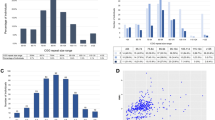Summary
Laird et al. (1987) hypothesized that there are at least four cis-acting alleles or ‘chromosome states’ at Xq27 that increasingly delay replication at this chromosomal area resulting in its increasing fragility in vitro. When on the inactive×chromosome, the proposed third (‘mutated’) allele can permanently block reactivation of its cis Xq27 area as the chromosome passes through female meiosis. Males and some females who inherit such an ‘imprinted’ fragile×chromosome (the fourth proposed allele) will be clinically affected due to impaired transcription of genes in the ‘imprinted’ Xq27 area. To test this hypothesis, late replication reverse banding patterns at Xq27 were evaluated in cultured lymphoblastoid cell lines from 25 subjects. Our data suggest that DNA replication of the presumed ‘imprinted’ Xq27 region in affected fragile×patients is indeed later relative to Xq27 on the active×chromosome in other subjects. These results support in part Laird's hypothesis of chromosomal imprinting in fragile×syndrome.
Similar content being viewed by others
References
Branda RF, Arthur DC, Woods WG, Danzl TJ, King RA (1984) Folate metabolism and chromosomal stability in the fragile×syndrome. Am J Med 77:602–611
Camargo M, Cervenka J (1980) Pattern of chromosomal replication in synchronized lymphocytes. I. Evaluation and application of methotrexate block. Hum Genet 54:47–53
Conner MK, Boggs SS, Turner JH (1978) Comparisons of in vivo BrdU labelling methods and spontaneous sister chromatid exchange frequencies in regenerating murine liver and bone marrow cells. Chromosoma 68:303–311
Fonatsch C (1981) A single method to demonstrate the fragile-X chromosome in fibroblasts. Hum Genet 59:186
Glover TW (1981) FUdR induction of the×chromosome fragile site: evidence for the mechanism of folic acid and thymidine inhibition. Am J Hum Genet 33:234–242
ISCN (1985) An international system for human cytogenetic nomenclature. Harnden DG, Klinger HP (eds) Published in collaboration with Cytogenet Cell Genet. Karger, Basel
Laird CD (1987) Proposed mechanism of inheritance and expression of the human fragile-X syndrome of mental retardation. Genetics 117:587–599
Laird C, Jaffe E, Karpen G, Lamp M, Nelson R (1987) Fragile sites in human chromosomes as regions of late-replicating DNA. Trends Genet 3:274–281
Ledbetter D, Airhart S, Nussbaum R (1986) Somatic cell hybrid studies of fragile (X) expression in a carrier female and transmitting male. Am J Med Genet 23:429–444
Nussbaum RL, Airhart SD, Ledbetter DH (1986) Recombination and amplification of pyrimidine rich sequences may be responsible for initiation and progression of the Xq27 fragile site: an hypothesis. Am J Med Genet 23:715–721
Pai GS, Thomas GH (1980) A new R-banding technique in clinical genetics. Hum Genet 54:41–45
Popovich BW, Rosenblatt DC, Copper BA, Vekemans M (1983) Intracellular folate distributions in cultured fibroblasts from patients with fragile×syndrome. Am J Hum Genet 35:869–878
Reddy KS, Savage JRK, Papworth DG (1988) Replication kinetics of×chromosomes in fibroblasts and lymphocytes. Hum Genet 79:44–48
Reiss AL, Hagerman RJ, Vinogradov S, Abrams M, King RJ (1988) Psychiatric disability in female carriers of the fragile×chromosome. Arch Gen Psychiatry 45:25–30
Schaap T (1989) The role of recombination in the evolvement of the fragile×mutation. Hum Genet 82:79–81
Sherman SL, Morton NE, Jacobs PA, Turner G (1984) The marker (X) syndrome: a cytogenetic and genetic analysis. Ann Hum Genet 48:21–37
Sutherland GR (1979) Heritable fragile sites on human chromosomes. I. Factors affecting expression in lymphocyte culture. Am J Hum Genet 31:125–135
Tommerup N, Poulsen H, Nielsen KB (1981) 5-fluoro-2′-deoxyuridine induction of the fragile site on Xq28 associated with×linked mental retardation. J Med Genet 18:374–376
Wang JC, Erbe RW (1984) Folate metabolism in cells from fragile×syndrome patients and carriers. Am J Med Genet 17:303–310
Warren ST, Zhang F, Licameli GR, Peters JF (1987) The fragile ite in somatic cell hybrids: an approach for molecular cloning of fragile sites. Science 237:420
Zakharov AF (1983) Pattern of DNA replication of the×chromosomes: normal and supernumerary. In: Sandberg AA (ed) Cytogenetics of the mammalian×chromosome, part A. Liss, New York, pp 357–374
Author information
Authors and Affiliations
Rights and permissions
About this article
Cite this article
Yu, WD., Wenger, S.L. & Steele, M.W. X chromosome imprinting in fragile×syndrome. Hum Genet 85, 590–594 (1990). https://doi.org/10.1007/BF00193580
Received:
Revised:
Issue Date:
DOI: https://doi.org/10.1007/BF00193580




